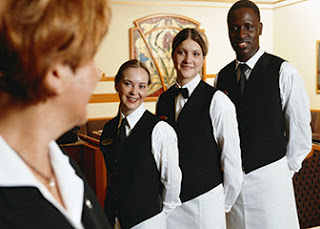Lower Tips Offset Higher Minimum Wage for Servers
From the Census Bureau:
Several states and municipalities across the United States have been raising the minimum wage well above the federal rate of $7.25 an hour, a trend studied by many economists.
Less attention has been paid to workers who rely on tips for part of their earnings. Recent research by the U.S. Census Bureau shows that rising minimum wages may increase server employment, but do not always result in higher pay for tipped workers.
“My research shows
that tipped workers are better off in terms of the wages they get from their employer, but their tips decrease,” said Maggie R. Jones, a senior economist at the Census Bureau, who published a working paper on the topic through the Census Bureau’s Center for Administrative Records Research.
The federal government requires a wage of at least $2.13 an hour or higher if the employee’s combined wages and tips don’t add up to the federal minimum. Many states require a higher minimum wage for tipped workers.
Jones’ research indicates that when the minimum tipped wage increases, more people are willing to work as waiters, waitresses, bartenders and other restaurant occupations that rely on tips. That means businesses can hire more people. The amount of tips on a given shift does not change but the number of people who work is higher. Therefore, the tips each server gets are less.
“You have more servers in a restaurant, more people on the floor at once,” she said.
Her research shows that:
When a state increases the tipped minimum wage, the part of servers’ pay that the employer pays directly goes up. A 10 percent increase in the tipped minimum wage increases total server pay by only 5 percent, because tips decline.
“While servers may benefit from a more stable wage, their hourly compensation does not appear to increase.”
When increases in the tipped minimum wage stayed below $5 per hour, more servers were hired. But for states that increased their minimum above about $5, server employment remained constant or decreased.
Jones’ research uses W-2 records that have separate fields for employer-paid wages and tips. These data permit a more accurate measure of hourly compensation for servers in the restaurant industry than most survey data. The administrative records are linked to Current Population Survey Annual Social and Economic Supplement data, which allows for calculation of wages, tips, hours worked and overall server employment.
Several states and municipalities across the United States have been raising the minimum wage well above the federal rate of $7.25 an hour, a trend studied by many economists.
Less attention has been paid to workers who rely on tips for part of their earnings. Recent research by the U.S. Census Bureau shows that rising minimum wages may increase server employment, but do not always result in higher pay for tipped workers.
“My research shows
that tipped workers are better off in terms of the wages they get from their employer, but their tips decrease,” said Maggie R. Jones, a senior economist at the Census Bureau, who published a working paper on the topic through the Census Bureau’s Center for Administrative Records Research.
The federal government requires a wage of at least $2.13 an hour or higher if the employee’s combined wages and tips don’t add up to the federal minimum. Many states require a higher minimum wage for tipped workers.
Jones’ research indicates that when the minimum tipped wage increases, more people are willing to work as waiters, waitresses, bartenders and other restaurant occupations that rely on tips. That means businesses can hire more people. The amount of tips on a given shift does not change but the number of people who work is higher. Therefore, the tips each server gets are less.
“You have more servers in a restaurant, more people on the floor at once,” she said.
Her research shows that:
When a state increases the tipped minimum wage, the part of servers’ pay that the employer pays directly goes up. A 10 percent increase in the tipped minimum wage increases total server pay by only 5 percent, because tips decline.
“While servers may benefit from a more stable wage, their hourly compensation does not appear to increase.”
When increases in the tipped minimum wage stayed below $5 per hour, more servers were hired. But for states that increased their minimum above about $5, server employment remained constant or decreased.
Jones’ research uses W-2 records that have separate fields for employer-paid wages and tips. These data permit a more accurate measure of hourly compensation for servers in the restaurant industry than most survey data. The administrative records are linked to Current Population Survey Annual Social and Economic Supplement data, which allows for calculation of wages, tips, hours worked and overall server employment.

Comments